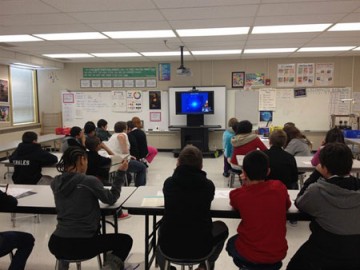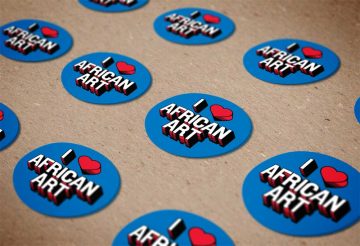Distance Learning
 Monday–Friday by appointment through the Center for Interactive Learning and Collaboration (CILC)
Monday–Friday by appointment through the Center for Interactive Learning and Collaboration (CILC)
1 hour
Elementary–high school
Please submit your request at least 4 weeks in advance using the online form at cilc.org.
Visit the museum without leaving your classroom! Through videoconferencing technology, students can experience real-time engagement with museum educators and Smithsonian experts. To learn more about available topics and flexible schedules, go to CILC.org and click on Content Provider Programs. The National Museum of African Art is listed in the drop-down menu.
How-to and Tips
- Check with your school technology coordinator to ensure your school has compatible videoconferencing equipment.
- At least 4 weeks before your preferred date, fill out the schedule form online with the CILC. All request forms will be routed directly to the museum’s education department, after which you will be contacted to confirm time and date, set up a test call, and discuss customizing the content of the program to your classroom needs.
- Exchange IP addresses and phone numbers for test call and for the day of the program.
- Complete a successful test call at the agreed time.
- At least 2 weeks prior to your program date, identify a space where all your students will be able to sit comfortably within your camera’s view, see a projected PowerPoint, and hear the videoconference presenter.
- Review pre-visit materials sent to you with your students.
- Encourage students to write down questions for the presenter elicited by the pre-visit activities and/or classroom content. Student interaction is always welcome!
Teacher Testimonial
It always helps the students learn when they have a different voice teaching them. The interactivity of this program [based on the exhibition African Cosmos: Stellar Arts] kept them totally attentive . . . The program corresponded perfectly with what our 6th grade is studying. I was so happy to find this program and the fact that it was free made it possible to happen. Thank you so much for such a wonderful, valuable program!”
–Pennwood Middle School, Pennsylvania
CILC Pinnacle Awards
 The National Museum of African Art was proud to receive a Pinnacle Award for the 2014–15 school year from the Center for Interactive Learning and Collaboration (CILC).
The National Museum of African Art was proud to receive a Pinnacle Award for the 2014–15 school year from the Center for Interactive Learning and Collaboration (CILC).
First awarded in 2008, the Pinnacle Award is given annually by the CILC to educational organizations that receive outstanding scores on educators’ and end users’ program evaluations. “Content providers always welcome feedback on their programs. The CILC Pinnacle Award is a way for educators to let providers know that they’re doing a great job!” said Darin Trobaugh, an education specialist at the Alaska Sealife Center.
The museum uses CILC as a platform for videoconferencing, extending the institution’s reach into classrooms around the country and around the world, and furthering its mission to inspire conversations about the beauty, power, and diversity of African arts and cultures worldwide. CILC is recognized nationally and internationally as the leader in content aggregation, consulting, and support services for using this and other types of collaborative technologies.
Receiving the award indicates remarkable quality of educational content and exceptional skill at program delivery. As it is based on end-user evaluations, “the Pinnacle Award is highly regarded by providers as it is an objective measure of their ability to meet the needs of students of all ages. CILC is gratified to see the growing ranks of Pinnacle awardees year after year,” said Jan Zanetis, CILC’s managing director. The museum is proud to count itself among these ranks!
Downloadable Resources





On May 11, the museum launched its first graphic novel in conjunction with its Connecting the Gems of the Indian Ocean initiative. The Song of Lionogo: An Indian Ocean Mythological Remix, by author and illustrator Jiba Molei Anderson, is based on a Swahili myth from East Africa and was inspired by the cultural connections between the Arabian Peninsula and the Swahili coast. Aimed at teens and youths, the novel offers an interactive and educational experience alongside a fast-paced adventure story. It incorporates a map of locations in the novel, a glossary to introduce new vocabulary words, and space for readers to draw their own plotlines and comic panels.
Guide to Talking about African Art
TK – TO DISCUSS WITH DEBORAH AND CHRIS
Teaching Resources
How to Look at African Art
Prepare Your Class to Visit the Museum
Pre- and post-visit activities introducing vocabulary, history, and background information can greatly enhance your class trip. Some tips and ideas are below.
For All AudiencesAsk: What 3 words do you think of when you hear the word “Africa”? (Save these lists for your classroom lesson after returning from your field trip to the museum.)
After the Visit:
Return your students’ word lists. Ask students to re-read their 3 written words.
Ask: What 3 different words do you think of when you hear the word “Africa” based on what you learned at the museum? Have students write the words on the same paper, titling the first 3 words “I used to think . . .” and the second group of 3 words “But now I think . . .”
Compare: Students’ lists. Did their associations stay the same? Change? How so?
For Younger Audiences
Introduce the group to what they will be doing on their museum visit—looking, listening, discovering, and sharing. (Be sure to include that students will have time to use the restrooms at the end of the gallery activity.)
Ask: What is a symbol? How do we use symbols to communicate?
During the Visit:
Point out a specific object on view. Research has shown that focusing on a small number of preselected objects keeps your student’s attention longer. Be open to what students can offer through close-looking and their unique points of view!
Ask: What do you see? What forms or shapes do you see? What colors, textures, or patterns? Start by asking students to simply describe what they see.
Ask: Describe what you are looking at. What is going on here? What does the expression tell us? What story is being told? Ask students to interpret what they observe.
Kindergarten and 1st Grade
Ask: How many countries are there in Africa? (There are 54!)
Ask: Define “symbol.” Explain that artists can use symbols to create visual meanings for cultures. For example, in our culture we have the American flag and the Liberty Bell. Remind students that cultural symbols come from a diversity of peoples from Africa.
Ask: What materials do artists use? Discuss materials such as beads, bone, fabric, ivory, metal, paint, raffia, and wood. Help your students identify these materials.
Discuss: What may artists’ choice of material mean or symbolize? Some examples within African communities include gold and ivory suggesting prestige, wealth, and royalty; wood indicating its abundance for artists living in and near forested areas in western and central Africa; or raffia reflecting the significant power of those same forested areas.
2nd and 3rd Grade
Inform students that Africa not one country, but a continent 3 times the size of the United States and comprised of 54 countries. It is home to more than 1,000 spoken languages. Remind students that Africa has thriving, modern cities and towns, and that the museum’s collection represents both traditional and contemporary art and artists.
Discuss: The diversity of the African continent and its geographic regions, including desert, savannah, forest, and mountains.
Ask: How might living in each region influence the production of art? For example, which materials would be available for making art in the forest? the mountains? a dense urban area?
Compare and contrast: Different lifestyles and ways of living. For example, how might life be different living in the city versus the country, or as a settled farming versus a nomadic herder?
Ask: How might different ways of life influence the production of art? For example, groups that move frequently with their herds often use smaller and transportable art, like jewelry, clothing, and body arts, to express their identity.
Supplement the above with photographs—you can find archival photos, postcards, and more at the online database of the museum’s Eliot Elisofon Photographic Archives at sirismm.si.edu/siris/eepatop.htm.
4th and 5th Grade
Demonstrate and discuss: Varying concepts of art and beauty. Help your students to gain acceptance and appreciation of new and potentially unfamiliar things.
Let students know that there are many ways to enjoy art. These can include your immediate reaction, but also learning and researching more, including things like: who produced the work; what the work was intended to represent; how and in what context the work was used or viewed; and what the work meant to the people that used or viewed it.
Supplement the above with photographs—you can find archival photos, postcards, and more at the online database of the museum’s Eliot Elisofon Photographic Archives at sirismm.si.edu/siris/eepatop.htm.
After the Visit:
Discuss: What might be missing when African art is viewed in an art museum? Some examples may be costume, dancers, music, choreography, or an audience. Art seen in a museum is often removed from its intended context.
For All Audiences
Involve: Students in planning the museum visit. Transportation logistics, lesson content and goals, and even students’ expected behavior can be a point of discussion at this level.
During the Visit:
Discuss: What students observe within smaller groups and amongst themselves. Give them the opportunity to teach what they know to others in the group.
Middle-school students tend to prefer facilitated (inquiry-based) approaches, and are turned off by a didactic (lecturing) approach. They are more likely to learn from “guide on the side” methods than from “sage on the stage”-type learning. Aim to be highly interactive!
Discuss: Topics such as current fashion, music, film, language, and peers’ accomplishments in the context of what they are seeing. These are of particular interest to middle school students because they tie in to identity formation and to the contemporary moment.
Middle school students are very social and see themselves as full participants versus just observers. They want to make connections between what they see in the museum and their own lives.
After the Visit:
Discuss: The importance of ritual and ceremony in marking important stages in life.
Compare and contrast: The importance of learning new skills and gaining new responsibilities in African society and in American society. For example, how do school graduation, religious ceremonies, community service, and voting relate to age or grade level? What are the symbols of these milestones?
